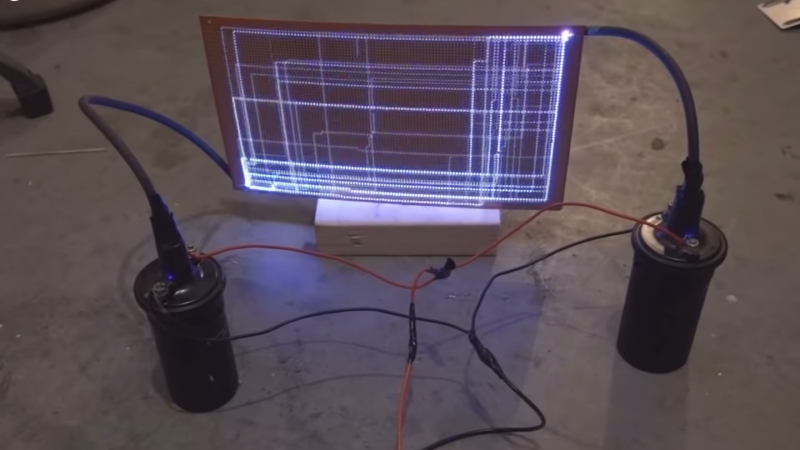You may have asked yourself at one time or another, “Self, what happens when you pass 100 thousand volts through a printed circuit board?” It’s a good question, and [styropyro] put together this fascinating bit of destructive testing to find out.
Luckily, [styropyro] is well-positioned to explore the high-voltage realm. His YouTube stock-in-trade is lasers, ranging from a ridiculously overpowered diode-laser bazooka to a bottle-busting ruby laser. The latter requires high voltage, of course, and his Frankenstein’s lab yielded the necessary components for this destructive diversion. A chopper drives dual automotive ignition coils to step the voltage up to a respectable 100 kV. The arcs across an air gap are impressive enough, but when applied to a big piece of copper-clad protoboard, the light show is amazing. The arcs take a seemingly different path across the board for each discharge, lighting up the path with an eerie blue glow accompanied by a menacing buzz. Each discharge path may be random, but they all are composed of long stretches across the rows and columns of copper pads that never take the more direct diagonal path. [styropyro]’s explanation of the math governing this behavior is feasible, but really we just liked looking at the pretty and dangerous display. Now if only the board had been populated with components…
No, there’s not much of a hack here, but it’s cool nonetheless. And it’s probably a well-earned distraction from his more serious stuff, like his recent thorough debunking of the “Chinese laser rifle” that was all over the news a while back.
[via r/electronics]















Cool, didn’t expect the path permutations, Noether might be turning in her grave.
Opens up a couple of intriguing display approach possibilities, thanks for posting :-)
Why Noether?
Just for the fun of it, if you want to up the ante… swap out those coils for some GM DIS ones. The rated output for those is close to twice what you’re using. Being a mechanic for the last 40 years, and having been ‘hit’ by them? Uh yeah… WAY more pain factor!!!!
I don’t know about the DIS, but I have been bitten by an HEI and a Jacobs CD system…both very memorable
Best line from the video “I wish this thing wasn’t so lethal because I’d love one for my room”
I wonder how much you could you drop the voltage if you sealed it in between two sheets of glass with a wide ring of silicone sealant and evacuated it to a very low pressure a bit like a plasma lamp.
One advantage of using standard glass would be that it is totally opaque for UV-B and UV-C.
Dropping the voltage isn’t what you want. Dropping the current is. First, you don’t use ignition coils, because they are really overkill (so to speak) for the effect. You want lots of voltage and very little current, while ignition coils can produce lots of voltage AND current. A Tesla coil is probably more appropriate for this sort of thing.
You’ve pretty much described the luminglass that shows up in 90% of sci-fi shows. (The green thing above 7 of 9’s Borg regeneration alcove.)
If you seal it in glass that would give protection against touching and thus avoid the lethality anyway
1.) use custom pcb to create custom patterns
2.) use custom pcb and driver circuit to create adressable plasma display
Yes. You can make pad shapes that make the diagonal and orthogonal paths close to the same length, which would give a whole different look.
I’d be really excited to build an air-based plasma display panel, but I haven’t the slightest idea how to find sufficiently high voltage drivers. Hopefully without using discrete transistors for everything.
Not only discrete transistors, but probably discrete coils for each channel :-(
Electricity does not take just one path of least resistance. It takes ALL paths of least resistance.
But it’s not as simple as that anyway: the arc in this case may be taking a “stepped leader” approach, by ionizing the air at each node in sequence, to create a path (or set of paths) of least resistance.
That’s like a Ka-W jammer. Possibly even more broadband
I’d love to see the output spectrum from those discharges. So many right angles, and so many different paths!
“You may ask yourself” was also the start of a “Talking Heads” track.
Reminds me of an “analog computer” someone built decades back to calculate the shortest path between two points on a map. It was basically a map of some city (New York IIRC?) etched onto a PCB, with the roads marked as dashed lines and empty space everywhere else. To find the shortest path between two points, connect a high voltage transformer between them and give the board a zap.
Inb4 “is this loss?” @ his wood etching pattern
Fascinating, so the paths jump around as the rings heat up thereby gaining resistance and so a new path of least resistance emerges?
I did not think about heat, but about electrical erosion by the discharge that changes the path lengths.